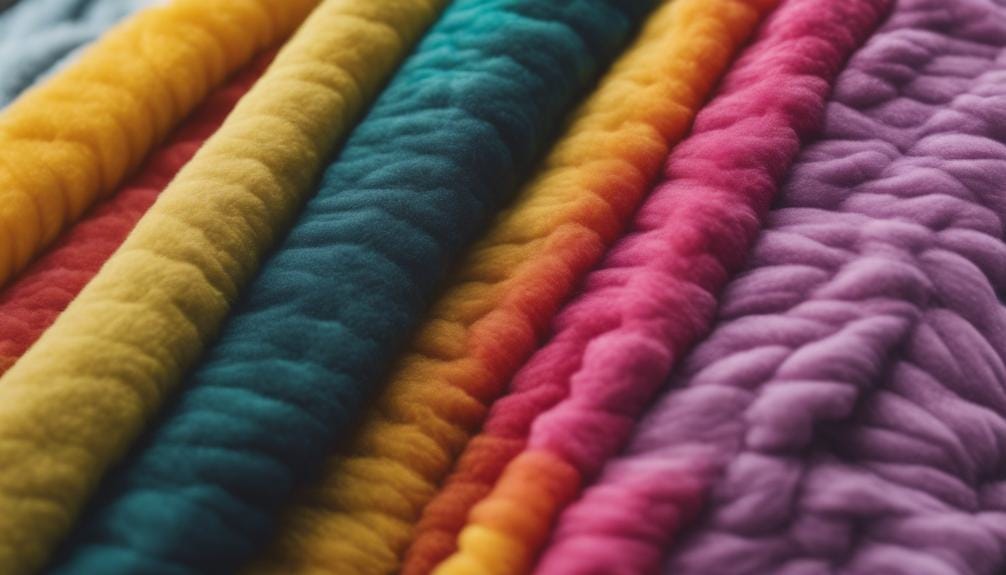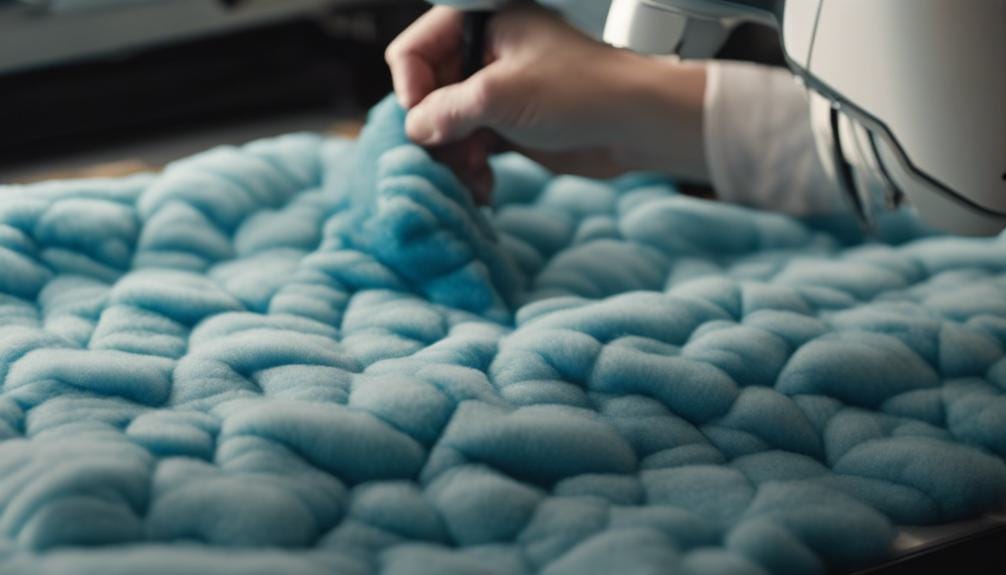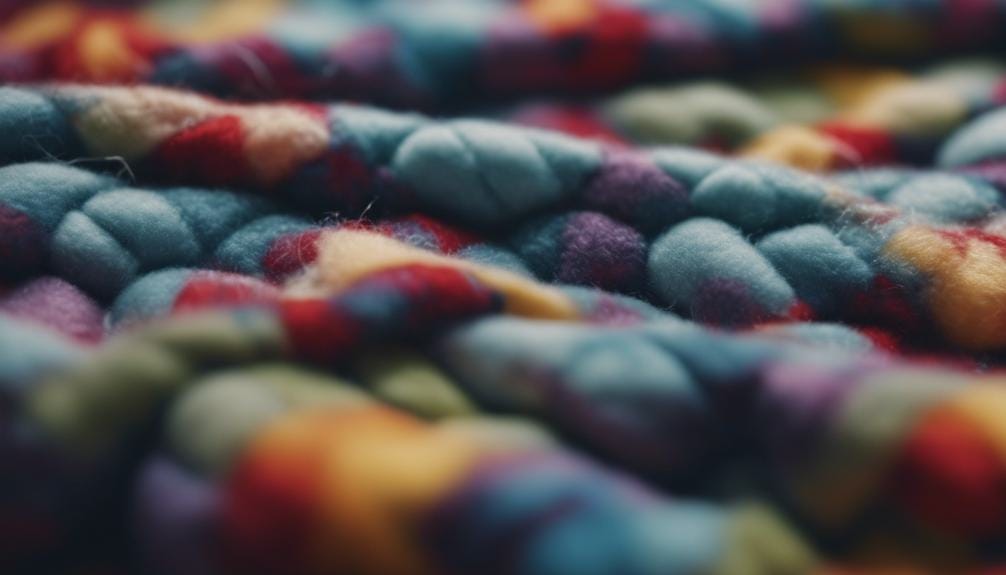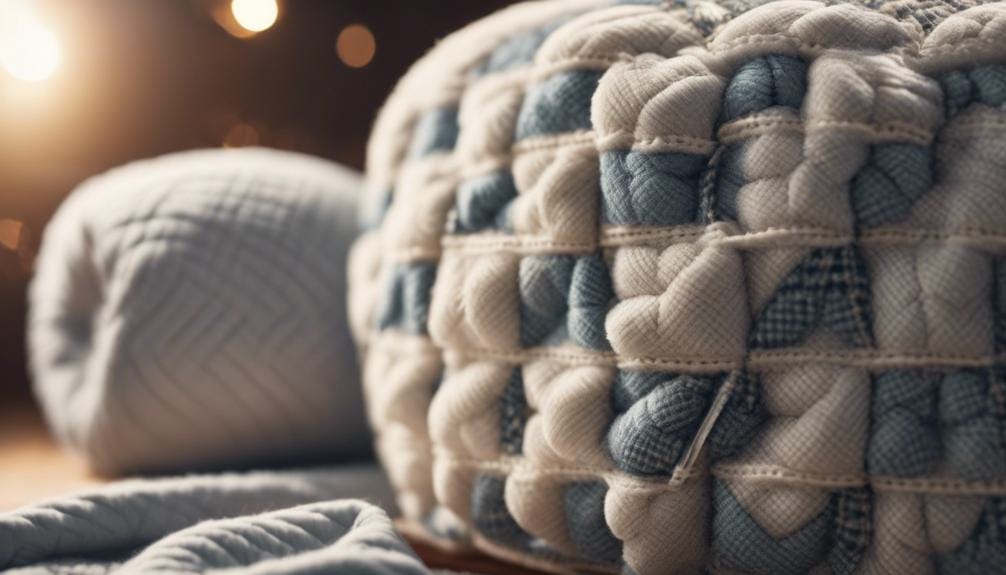How to Quilt Two Pieces of Fleece Together: Techniques and Tips
When quilting two pieces of fleece together, start by selecting the suitable stitching style for a secure seam. Securing the edges with clips or pins can keep the fabric aligned during the sewing process, aiding in a smoother finish.
But what about the stitching technique that works best with fleece? Stay tuned to discover the most effective method to achieve professional-looking results when quilting fleece fabric together.
Key Takeaways
- Prioritize anti-pill fleece for a smooth look and durability.
- Use soft, not too thick fleece for comfort when quilting.
- Secure fleece layers with clips or pins for stability.
- Wash fleece quilt gently to maintain softness and quality.
Choosing the Right Fleece Fabric
When selecting the ideal fleece fabric for quilting two pieces together, prioritize anti-pill fleece to maintain a smooth appearance and prevent fabric bobbling. Anti-pill fleece is designed to resist the formation of those pesky balls of fiber that can detract from the overall look of your quilt. Opting for this type of fleece ensures that your quilt will stay looking fresh and new for longer periods.
Anti-pill fleece is a great choice not only for its appearance but also for its comfort. Look for fleece that’s soft and not too thick, providing a cozy backing for your quilt project. This type of fleece is resistant to pilling, making it a durable option that will stand the test of time.
Consider using Polar fleece when quilting two pieces together. Polar fleece is known for its warmth, durability, and cuddly qualities, making it an excellent choice for creating a snug and inviting quilt. Its soft texture adds an extra level of comfort to your project, ensuring that your quilt will be both visually appealing and cozy to snuggle up with.
Preparing the Fleece Pieces

After choosing the right fleece fabric for quilting two pieces together, the next step is to prepare the fleece pieces by washing and drying them before starting your project. Washing and drying the fleece is essential to prevent any shrinkage or distortion that could occur later on. Make sure to follow the manufacturer’s instructions for washing to maintain the quality of the fabric.
Once the fleece pieces are clean and dry, the next important step is to trim the edges of the fleece. Trimming the edges ensures that they’re straight and even, which will make it easier to align the pieces together when quilting. Use fabric scissors or a rotary cutter and a quilting ruler to achieve clean and precise edges.
To keep the fleece pieces in place during quilting, use clips or pins to secure them together. This will help maintain alignment and prevent any shifting while stitching. Consider using a walking foot on your sewing machine when quilting two pieces of fleece. The walking foot helps to feed the layers of fleece evenly, reducing the chances of fabric shifting.
Layering the Fleece for Quilting

To achieve a smooth and cozy quilt top, layer the two fleece pieces with their right sides facing out. Ensuring the fleece for the backing is positioned correctly is crucial for a professional-looking quilt. Here are some steps to guide you through the process:
- Align Edges Properly: Make sure the edges of the fleece pieces are matched up accurately. Proper alignment will prevent shifting during quilting and result in a neat finish.
- Use Pins for Stability: Secure the layers together using pins. This will help prevent any slippage during the quilting process, keeping your quilt top smooth and even.
- Place Quilt Top on Top: When layering the fleece pieces, remember to place the quilt top on top of the fleece for the backing. This arrangement ensures that the design on the quilt top is visible and adds a decorative touch to the finished quilt.
Sewing Techniques for Quilting Fleece

To ensure the fleece layers stay in place while sewing and to achieve a professional finish, utilize a walking foot or even-feed foot when quilting fleece. These specialized presser feet help prevent the top and bottom layers of fleece from shifting during the quilting process, resulting in more precise and even stitching.
When quilting fleece, it is recommended to sew with a longer stitch length, typically around 3.0-3.5. This longer stitch length helps prevent bunching of the fabric and ensures a smooth quilting experience. Additionally, consider using quilting clips or pins to secure the fleece layers together before stitching. This will help maintain alignment and prevent any shifting while sewing.
Below is a table summarizing key sewing techniques for quilting fleece:
| Sewing Techniques | Description |
|---|---|
| Use a Walking Foot | Prevents layers from shifting while quilting fleece. |
| Sew with Longer Stitch Length | Helps prevent bunching and ensures a smooth quilting process. |
| Secure with Clips or Pins | Maintains alignment and prevents shifting of fleece layers during sewing. |
Experiment with different quilting patterns and designs to enhance the appearance and texture of your finished fleece quilt. Before working on your main project, practice on scrap fleece pieces to test tension, stitch length, and overall technique for the best results.
Finishing Touches and Care Instructions

For a polished finish and longevity, consider trimming excess fleece and binding the edges with coordinating fabric on your quilt. Trimming the excess fleece will create a clean edge, giving your fleece-backed quilt a professional look. Binding the edges with coordinating fabric not only adds durability but also provides a polished finish to your quilt.
- Trim Excess Fleece: After quilting your project, trim the excess fleece from the edges using sharp scissors or a rotary cutter. Be careful not to cut into the seams, ensuring a clean and neat edge.
- Quilt Binding: Attach quilt binding to the edges of your fleece quilt to secure the layers together and create a finished look. Choose a coordinating fabric that complements your fleece for a cohesive appearance.
- Cotton Batting: Consider using cotton batting when making a fleece-backed quilt. Cotton batting is breathable, lightweight, and provides warmth without adding bulk to your quilt.
To care for your fleece quilt, wash it gently to maintain its softness. Avoid using high heat while drying to prevent damage to the fleece. Store your quilt in a cool, dry place to preserve its quality over time. Regularly check for wear or pilling on the fleece and air the quilt out outdoors to refresh the fabric.
Frequently Asked Questions
Can Fleece Fabric Be Quilted?
Yes, fleece fabric can be quilted. It provides a soft and plush texture, ideal for cozy projects. Consider using a walking foot or regular sewing machine foot for even stitches. Experiment with different designs to enhance your quilt.
How Do You Sew Fleece Squares Together?
To sew fleece squares together, align them with right sides facing, stitch around the edges with a 1/2 inch seam allowance using a ballpoint needle and polyester thread. Turn inside out, hand-stitch the opening, and press for a smooth finish.
Can I Use Fleece Instead of Batting for a Quilt?
Yes, you can use fleece instead of batting for a quilt. Fleece offers warmth and a plush texture similar to batting. It creates a fluffy, crinkly finish without extra layers. Using fleece results in soft, cuddly quilts.
How Do You Make a Quilt Out of Two Pieces of Fabric?
To make a quilt out of two pieces of fabric, lay them together, pin the edges, sew around leaving an opening, turn right side out, and stitch closed. Optionally quilt by sewing lines or patterns across.
Conclusion
Now that you have learned how to quilt two pieces of fleece together, you can create cozy and unique projects with ease. Remember to choose the right fleece fabric, prepare and layer it properly, use suitable sewing techniques, and finish with care instructions for a successful quilt.
Experiment with different techniques and fabrics to make your fleece quilts stand out and enjoy the warmth and comfort they provide. Happy quilting!



